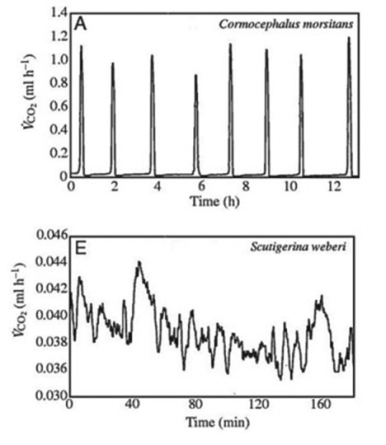Use the following information and figures to answer the question.
Many terrestrial arthropods exchange gases with their environments by using tracheae, tubes that lead from openings (called spiracles) in the animal's exoskeleton or cuticle directly to the animal's tissues. Some arthropods can control whether their spiracles are opened or closed; opening the spiracles allows the carbon dioxide produced in the tissues to travel down the tracheae and be released outside the animal. Klok et al. measured the carbon dioxide emitted over time (represented by ⱽCO₂) by several species of centipedes. The figures present graphs of their results for two species, Cormocephalus morsitans and Scutigerina weberi.
How would a terrestrial centipede most likely benefit from the ability to close its spiracles? Closing spiracles would ________.
A) allow the centipede to move more quickly
B) allow the centipede to retain more moisture in its tissues
C) allow the centipede to stay warmer
D) allow more oxygen from the environment to reach the centipede's tissues
Correct Answer:
Verified
Q48: Use the following information and figures to
Q49: Use the following information to answer the
Q50: Use the following information and figures to
Q51: Use the following information and figures to
Q52: Arthropod exoskeletons and mollusc shells both _.
A)
Q54: The heartworms that can accumulate within the
Q55: You find a multi-legged animal in your
Q56: Imagine that you are a graduate student
Q57: Without genetic variation, evolution cannot occur. Sexual
Q58: A terrestrial animal species is discovered with
Unlock this Answer For Free Now!
View this answer and more for free by performing one of the following actions

Scan the QR code to install the App and get 2 free unlocks

Unlock quizzes for free by uploading documents